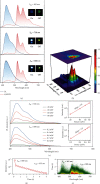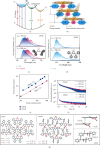Near-Infrared-Excitable Organic Ultralong Phosphorescence through Multiphoton Absorption
- PMID: 33623903
- PMCID: PMC7877391
- DOI: 10.34133/2020/2904928
Near-Infrared-Excitable Organic Ultralong Phosphorescence through Multiphoton Absorption
Abstract
Organic ultralong room-temperature phosphorescence (OURTP) with a long-lived triplet excited state up to several seconds has triggered widespread research interests, but most OURTP materials are excited by only ultraviolet (UV) or blue light owing to their unique stabilized triplet- and solid-state emission feature. Here, we demonstrate that near-infrared- (NIR-) excitable OURTP molecules can be rationally designed by implanting intra/intermolecular charge transfer (CT) characteristics into H-aggregation to stimulate the efficient nonlinear multiphoton absorption (MPA). The resultant upconverted MPA-OURTP show ultralong lifetimes over 0.42 s and a phosphorescence quantum yield of ~37% under both UV and NIR light irradiation. Empowered by the extraordinary MPA-OURTP, novel applications including two-photon bioimaging, visual laser power detection and excitation, and lifetime multiplexing encryption devices were successfully realized. These discoveries illustrate not only a delicate design map for the construction of NIR-excitable OURTP materials but also insightful guidance for exploring OURTP-based nonlinear optoelectronic properties and applications.
Copyright © 2020 Ye Tao et al.
Conflict of interest statement
The authors declare no competing financial interests.
Figures





References
-
- Gu L., Shi H., Bian L., et al. Colour-tunable ultra-long organic phosphorescence of a single-component molecular crystal. Nature Photonics. 2019;13(6):406–411. doi: 10.1038/s41566-019-0408-4. - DOI
LinkOut - more resources
Full Text Sources
Miscellaneous

